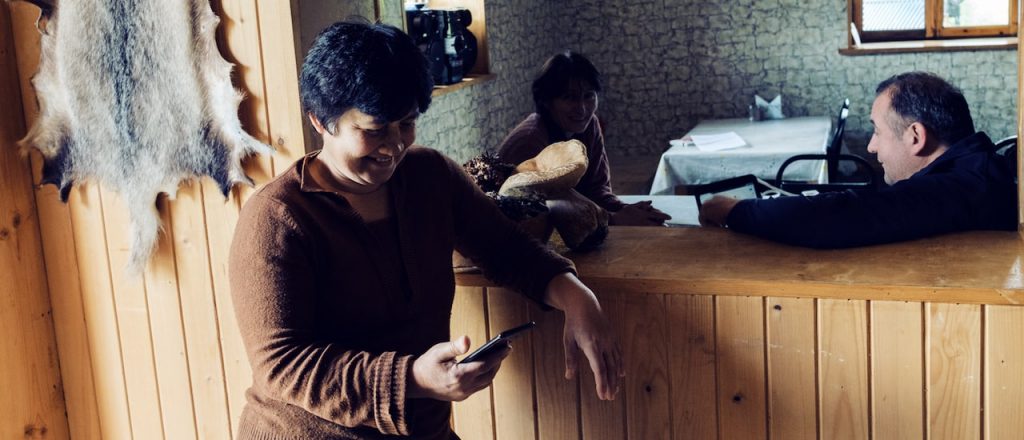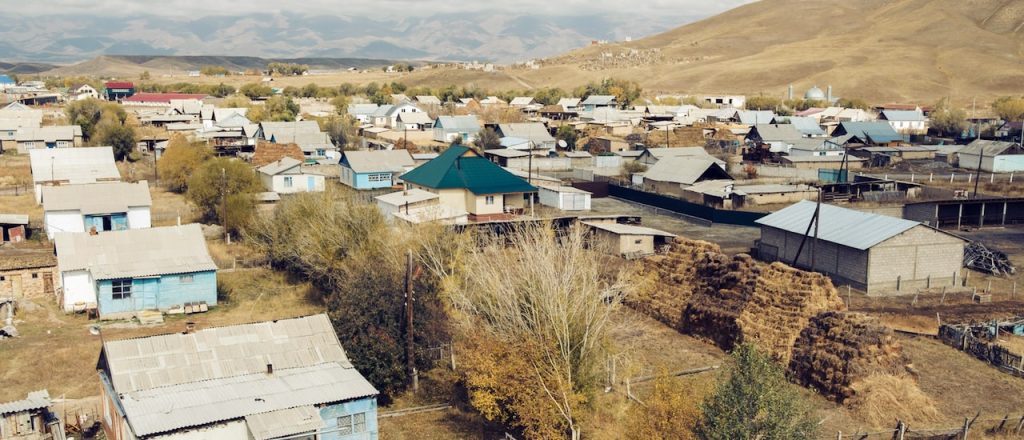Author Archives: Maarit Palovirta
Author Archives: Maarit Palovirta

Connecting the most remote and challenging territories of any country to the Internet can be tough. Typically, Internet access spreads gradually from urban conglomerations towards smaller hubs, and finally, to the most remote and sparsely populated areas. This is just common business sense.
Many of these remote areas are unique in terms of their people, culture, and livelihood, and Internet access can make a world of difference. This was the case when the Internet Society, together with its local partners, launched the first community network in Georgia, in the mountainous region of Tusheti, in September 2017.
Creating Impact
One year on, the Internet has made a significant difference to the lives of the Tushetians. This week, the Internet Society published an impact assessment on the Tusheti community network highlighting the transformation in tourism, e-commerce, and people’s livelihoods.
The Internet has had a positive impact on tourism through more effective online advertising and sales, and through efficiencies in businesses operations. With these encouraging developments, local residents are investing in the construction and opening of new guesthouses. The Internet has also increased the levels of safety and mobility in this remote part of the world by providing a communications channel to Continue reading

Asylbek Sanarbekov, a social worker in the village of Suusamyr, Kyrgyzstan, can often be seen standing outside of his office building, phone in hand. He goes there to connect to the new Suusamyr Community Network, which has antennas on a nearby water tower. The Suusamyr Community Network officially launches today at the Community Network Xchange (CNX) in New Delhi. It’s a big improvement over Sanarbekov‘s connection at home, where he uses expensive and sometimes unreliable mobile data.
The village of Suusamyr is located in the Suusamyr Valley, a remote region in the Tian Shan Mountains. It’s a popular tourist destination thanks to its breathtaking landscape and its sparse population, with just over 3,000 residents. During the warmer months, they’re employed in agriculture, but by winter, thanks to heavy snowfall and subfreezing temperatures, many are unemployed.
“We are a small, landlocked mountainous country, so the traditional economic models do not necessarily work for us,” says Talant Sultanov, chair of the Internet Society‘s Kyrgyz Chapter. “We decided that digital development is the way forward.”
There’s a mobile connection in the village of Suusamyr, but according to Mairambek Ismailov, deputy head of the local self-government body, it’s not necessarily fast, reliable, or Continue reading

Last week, the Internet Society together with our Kyrgyz chapter and the wider local community held discussions about Internet connectivity in remote areas in Bishkek, Kyrgyzstan. Approximately 35% of the Kyrgyz population use the Internet (ITU data, 2017) and most users are located in cities and urban areas.
In cooperation with its Kyrgyz chapter, the Internet Society is piloting the community networks approach in the village of Suusamyr, located some 150 kilometers south of the capital city Bishkek. We had an opportunity to visit this village of about 4000 people, tucked away in a wide valley surrounded by high mountains. The economic activity revolves around farming, horse and cattle keeping, and tourism.
While the final phase of the Suusamyr community network is still under implementation, we can already draw some lessons learnt from the preparatory and testing phases.
Partnerships
As a starting point, the Internet Society Kyrgyz chapter consolidated a partnership with the government, Internet Service Providers (ISP), and the local community in Suusamyr. The Kyrgyz government saw the opportunity for local economic development. Two ISPs agreed to lease their existing backbone infrastructure to connect the last mile. And most importantly, the local community embraced this initiative with a Continue reading
While Europe tops many charts in terms of Internet connectivity in global comparison, a number of challenges still persist. One of these challenges is the continuing urban-rural digital gap, which concerns many countries both in Western and Eastern Europe.
According to Eurostat, on average in the European Union (EU) 88% of households in urban areas are connected to broadband as opposed to 79% of rural households. (Broadband connection is defined as “a connection enabling higher than 144 Kbit/s download speed”, European Commission 2016.) In a few Southern and Southeastern EU countries, the broadband gap between urban and rural areas is well above 20%.
The Internet Society partnered with the Centre for European Policy Studies (CEPS) to examine the digital gap in Europe and to assess the role of community networks in the European context. This new paper looks at five different community network examples from around Europe and draws some key lessons learnt from these experiences.
Community networks are not a new thing in Europe. In fact, some of the well-established ones date back to the 1990’s. Community networks provide a innovative solutions to unserved or underserved areas, where the business case for investment by commercial operators is Continue reading
The 12th edition of the European Dialogue on Internet Governance or the EuroDIG, as it is commonly known, took place in Tbilisi, Georgia, on 5-6 June. The Internet Society (ISOC) is an institutional partner to EuroDIG and the ISOC European Regional Bureau helped shape the agenda and were involved in several sessions.
This year, a few specific aspects caught my attention and created a lot of debate during the sessions and in the corridors.
Reinforcing the multistakeholder model
While European governments have traditionally been strong supporters of the Internet Governance Fora (IGF) and the multistakeholder model, this support has been to some extent compromised by concerns over national security and other priorities in the recent times. Several core members of the European Internet community have talked about a “fatigue” with the regional and national IGFs.
This year’s EuroDIG offered some fresh food for thought. Larry Strickling, who leads the Internet Society’s Collaborative Governance project, made several interventions during the EuroDIG. Strickling’s extensive experience of driving multistakeholder processes and his practical approach were received with great interest and curiosity. In parallel, high participation from young people injected heaps of new energy and optimism to the event.
Embracing the Internet opportunity Continue reading
The year 2017 was an important milestone in moving forward the European agenda for Digital for Development (D4D). The European Commission (EC) paper on mainstreaming digital technologies into EU development policy and the European Council conclusions on Digital for Development have activated the European development community to share opinions and ideas on how to help bridge the global digital divide.
In the past month, we have had a couple of open events in Brussels to discuss this important issue. The European Parliament’s EPP group hosted a public hearing on Digitalisation for Development to collect ideas and to push for more progress. Two weeks later, the EC held the first multistakeholder meeting for Digital4Development with a focus on Africa.
Building a Balanced Agenda
There are a number of pillars of activities that most stakeholders agree on. These include Internet access with a focus on last mile; Internet as an enabler across different sectors; skills; and entrepreneurship. During the recent meetings, the EC, the national development agencies and the private sector showcased impressive and innovative digitalisation programmes.
However, several stakeholders pointed out that while it is important to continue to invest in Internet access, this is no longer enough. We need Continue reading
Wondering how the Internet will impact your future in Europe? You’re not the only one.
We are only beginning to understand the full value that the Internet can bring to tomorrow’s world.
So how can we make certain the Internet of the tomorrow will help to do things like create jobs, ensure every citizen has access to municipal services, and close the divide between urban and rural areas?
A series of global talks now known as the Internet Society’s Regional Internet Development Dialogues are intended to help answer those questions and more.
The next one is in Brussels, Europe on November 7th 2017 and you’re invited:
Internet of Opportunity: Will the Internet Benefit all Europeans?
By bringing together people from very different backgrounds, these dialogues are meant to create a way for people to hear views and opinions outside of their comfort zone – and also to build understanding and unexpected partnerships.
The full day event, which is open to everyone who feels they have a stake in the Internet’s future, will bring together policy and decision makers, business leaders, and Europeans who want to make sure people can build a prosperous future.
Now is your chance to tell some Continue reading
About a year ago, Internet Society partnered with its Georgian Chapter, Small and Medium Telecom Operators Association of Georgia, Freenet LTD Association, Internet Development Initiative and Tusheti Development Fund to help the remote and mountainous region of Tusheti to build access to the Internet. The network was recently completed as a true community effort and became fully operational in August.
Impact
When the Internet Society team visited the village of Omalo in Tusheti two weeks ago for an official launch ceremony, the Internet speeds measured at 4-5 Mbps. A dramatic change to a region, where many villages are not even covered by mobile signal!
During our brief stay in Omalo the impact of the newly established Internet connection was not evident at first glance. Apart from a couple of visible repeaters on the surrounding mountains, people were getting on with their usual daily chores while a group of tourists travelled past on horseback. The local community, however, was exuding a sense of achievement and optimism. The recently established Internet access opens new opportunities for tourism and cultural preservation, and provides an essential communication channel for healthcare and potential emergency situations.
Partnership
The engine behind this effort was a solid Continue reading